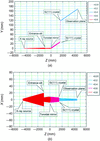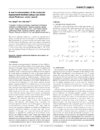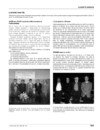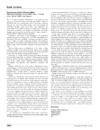issue contents
May 2001 issue

Cover illustration: Composite diagram showing the different aspects of synchrotron radiation covered by the Journal of Synchrotron Radiation
facility information
research papers
X-ray standing waves are generated in (001) backscattering geometry for a TiSe2 single crystal at hν ≃ 1033 eV. The modulation of the photoelectron yield was measured as a function of the photon energy. The data reveal disorder along the c-axis.
X-ray polarization-contrast images due to X-ray magnetic circular dichroism in the hard X-ray region have been successfully recorded for the first time.
To test for the extent of radiation damage occurring during synchrotron radiation circular dichroism (SRCD) spectroscopic measurements at vacuum ultraviolet wavelengths, the chemical integrity and secondary structure of the protein myoglobin were examined by gel electrophoresis, mass spectrometry and SRCD spectroscopy. No changes were detected by any of these methods even after extensive irradiation, indicating that damage does not occur during SRCD measurements.
The simultaneous detection of contrast agents by fluorescent X-ray computed tomography (FXCT) with synchrotron radiation is examined. FXCT could image the distribution of both iodine and xenon agents in a phantom clearly and the contrast ratio was significantly better than that of transmission X-ray computed tomography images.
A 2.3 to 25 keV XAS beamline at LNLS is described. Its main characteristics, regarding photon flux, harmonic contamination, energy resolution and energy stability, are discussed in terms of recent commissioning results.
A new ray-tracing program has been developed. It traces consecutively each ray, following its path, and treats diffraction by a monochromator crystal by adopting the Darwin–Prins theory.
A six-dimensional exhaustive search algorithm has been developed to search unknown target structures in the Patterson vector space. The determination of both the rotation and translation parameters simultaneously is shown to have several advantages.
short communications
The fabrication and testing of linear silicon diffractive lenses for hard X-rays is described.
Examples are reported of how X-ray absorption spectroscopy can be used as a powerful tool for investigating sulfur in biological molecules.
letters to the editor
Free 

A new optical effect observed by Goulon et al. using linearly polarized synchrotron radiation is briefly reviewed with the underlying simplicity discussed from a symmetry point of view.
current events
Free 

Free 

Free 

book reviews
Free 



 journal menu
journal menu







































